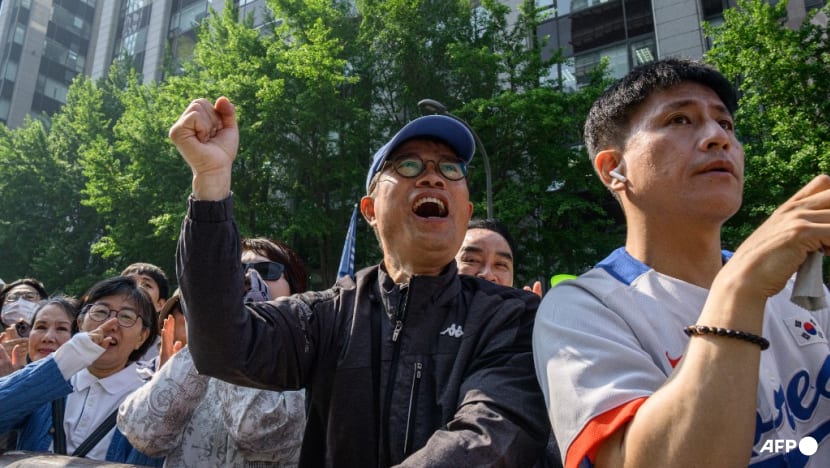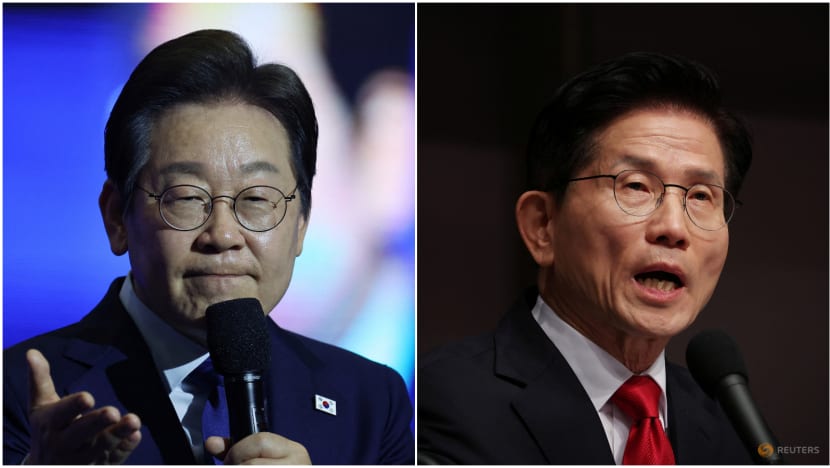Commentary: South Korea is lurching from crisis to crisis ahead of June's election
South Korea’s snap election on Jun 3 comes after months of instability, but changing the president may not be enough to steady the system, says political science professor Robert Kelly.

A supporter gestures during an election campaign event in Seoul on May 12, 2025. (Photo: AFP/Anthony Wallace)

This audio is generated by an AI tool.
BUSAN: Since Dec 3, when now-impeached president Yoon Suk Yeol declared martial law, South Korean politics has stagnated.
In the five months since, South Korea has cycled through thee acting presidents. Meanwhile, a new president has been elected in South Korea’s most important ally – the United States – yet Seoul has been unable to meaningfully negotiate with US President Donald Trump on major issues because of persistent political deadlock.
Mr Yoon was formally removed from office last month by the Constitutional Court, intensifying the country’s sharp partisan polarisation. Mr Yoon’s impeachment means a new election will be held on Jun 3.
But South Korea has gone from crisis to crisis in the lead-up to the vote, with little sign of political consolidation. This past weekend, the country’s conservative party – the People Power Party (PPP) – imploded into factionalism, unable to agree on a candidate.
South Korea's former labour minister Kim Moon-soo had earlier this month won the PPP's primary to run as its candidate. But before dawn Saturday (May 10), the PPP changed its mind and nominated former prime minister Han Duck-soo instead. Mr Kim was eventually reinstated as PPP’s candidate on the same day.
The two contenders have struggled back and forth quite publicly. The infighting and chaotic manoeuvrings may well throw the election to progressive Lee Jae-myung, who is already the favourite.
Unsurprisingly, this turmoil has prompted talk of constitutional reform. Many proposals recommend South Korea move away from its current system of a single, five-year presidential to the American system of a four-year presidential term with the possibility of re-election once. Unfortunately, this will not fix the country’s structural issues, the most important of which are listed below.

AN OVERPOWERED PRESIDENCY
South Korea’s president has wide power to govern with minimal consultation with the country’s legislature. Particularly on foreign policy, South Korean presidents – of both political camps – frequently govern in a monarchic style.
For example, South Korea’s last progressive president – Moon Jae-in – reached out to North Korea while ignoring the National Assembly and public opinion on this highly divisive issue. Hyper-presidential power like this creates intense, zero-sum competition to control this one super office, worsening partisan polarisation.
This is a widely noted problem in presidential democracies. Latin American republics, the United States and France all have similarly over-powered presidencies. Political science even has a term for this problem: the “imperial presidency”.
Importantly, adopting the two-term American presidential election system will not fix this problem for South Korea. Instead, the South Korean legislature needs to improve accountability and information provision from the presidency.
THE LACK OF A VICE-PRESIDENT
Rebalancing the presidency and legislature is the most obvious constitutional change needed in South Korea, especially given the country’s sharp partisan divide. Less obvious though is the drift created by the lack of a vice-presidency. South Korea is the only major presidential democracy without an empowered vice-president who can govern if a president is incapable.
Instead of a vice president, South Korea’s constitution mandates the country’s prime minister step in as acting president if the president dies, is removed, very ill and so on. Unfortunately, the prime minister is not elected; he is appointed by the president. So he has no independent electoral legitimacy on which to base his acting presidency.
Further, the constitution demands that a new election be held within a few months of presidential incapacitation. The leaves the acting president as a weird caretaker unable to make major decisions for several months.
Many conservatives did not want the role after Mr Yoon’s fall, because they wanted to run for president. The result is that the current acting president is the former education minister. Any constitutional reform should create a proper vice-president who can govern robustly.
South Korea is a large, complex economy with serious regional security challenges. It is unnecessarily risky for it to drift in this manner for months.
CONSERVATIVE PARTY INSTITUTIONALISATION
The final structural issue revealed by the post-Dec 3 chaos is the inability of the South Korean conservative party to function as a modern political party. This is not formally a constitutional issue, of course; the PPP is not in the constitution. But the South Korean constitution does assume parties will compete for power, and multiparty democracy requires at least two coherent, governing-capable parties if voters are to have real electoral choice. The PPP is no longer such a party.
Mr Yoon is the conservatives’ second president in a row to be impeached. Conservative Park Geun-hye was also impeached in 2017. In both instances, the country’s High Court found unanimously that the president should be removed. This strongly suggests that even if the impeachment process was originally motivated by partisanship, the case for impeachment was objectively strong.
The PPP has struggled with internal institutions and rules for years, and it has no coherent platform outside of foreign policy hawkishness. Reflecting this weak sense of identity has been the party’s multiple name changes: at least five in the last 20 years.
By contrast, South Korea’s progressive party has been known by its name – the Democratic Party – for decades, and its ideological commitments – to the welfare state, to détente with North Korea – are easier to identify.
Given weak institutionalisations, the PPP has unsurprisingly struggled with candidate recruitment. Mr Yoon, for example, was a political novice and outsider who parachuted into the party to suddenly run for president in 2022. The Democrats would probably not select a candidate so rashly. Mr Lee, for example, is a known quantity and has been around for decades.
Constitutional reform can improve the South Korean system’s resilience to traumas like impeachment. But improving the quality of conservative governance – to avoid such flawed candidates in the future – will take years to right. The South Korean conservatives will likely lose next month. They should use the time to foundational rebuild their party.
Robert Kelly (@Robert_E_Kelly) is a professor of political science at Pusan National University.



















